Casein Micelles as Nanocarriers for Benzydamine Delivery
Abstract
:1. Introduction
2. Materials and Methods
2.1. Preparation of Blank Casein Nanoparticles and BZ-Loaded Casein Nanoparticles
2.2. Characterization
2.2.1. Production Yield, Drug Loading and Entrapment Efficiency
2.2.2. Particle Size Analysis, Size Distribution and Zeta Potential
2.2.3. SEM Analysis
2.2.4. FTIR Spectroscopy
2.2.5. Differential Scanning Calorimetry (DSC)
2.2.6. In Vitro Drug Release
3. Results and Discussion
3.1. Synthesis and Characterization of Blank Casein Nanoparticles
3.2. Synthesis and Characterization of BZ Loaded Casein Nanoparticles
3.2.1. Drug Loading and Entrapment Efficiency
3.2.2. Production Yield
3.2.3. Particle Size and Size Distribution
3.2.4. Surface Morphology
3.2.5. Differential Scanning Calorimetry (DSC)
3.2.6. Fourier-Transform Infrared Spectroscopy (FTIR)
3.2.7. In Vitro Drug Release
4. Conclusions
Author Contributions
Funding
Institutional Review Board Statement
Informed Consent Statement
Data Availability Statement
Acknowledgments
Conflicts of Interest
References
- Sundar, S.; Kundu, J.; Kundu, S.C. Biopolymeric nanoparticles. Sci. Technol. Adv. Mater. 2010, 11, 014104. [Google Scholar] [CrossRef]
- Gandhi, S.; Roy, I. Doxorubicin-loaded casein nanoparticles for drug delivery: Preparation, characterization and In Vitro evaluation. Int. J. Biol. Macromol. 2019, 121, 6–12. [Google Scholar] [CrossRef]
- Couvreur, P.; Gref, R.; Andrieux, K.; Malvy, C. Nanotechnology for drug delivery: Aplication to cancer and autoimmune diseases. Prog. Solid State Chem. 2016, 2–4, 231–235. [Google Scholar] [CrossRef]
- Głąb, T.K.; Boratyński, J. Potential of casein as a carrier for biologically active agents. Top. Curr. Chem. 2017, 375, 71. [Google Scholar] [CrossRef] [Green Version]
- Elzoghby, A.O.; El-Fotoh, W.S.; Elgindy, N.A. Casein-based formulations as promising controlled release drug delivery systems. J. Control. Release 2011, 153, 206–216. [Google Scholar] [CrossRef]
- Bhat, M.Y.; Dar, T.A.; Singh, L.R. Casein Proteins: Structural and Functional Aspects. In Milk Proteins—From Structure to Biological Properties and Health Aspects; Gigly, I., Ed.; InTech: London, UK, 2016. [Google Scholar] [CrossRef] [Green Version]
- Fox, P.; Brodkorb, A. The casein micelle: Historical aspects, current concepts and significance. Int. Dairy J. 2008, 18, 677–684. [Google Scholar] [CrossRef]
- Dalgleish, D.G. Casein micelles as colloids: Surface structures and stabilities. J. Dairy Sci. 1998, 81, 3013–3018. [Google Scholar] [CrossRef]
- Liu, Y.; Guo, R. pH-dependent structures and properties of casein micelles. Biophys. Chem. 2008, 136, 67–73. [Google Scholar] [CrossRef]
- Liu, Z.; Juliano, P.; Williams, R.P.; Niere, J.; Augustin, M.A. Ultrasound effects on the assembly of casein micelles in reconstituted skim milk. J. Dairy Res. 2014, 81, 146–155. [Google Scholar] [CrossRef]
- Liu, C.; Yao, W.; Zhang, L.; Qian, H.; Wu, W.; Jiang, X. Cell-penetrating hollow spheres based on milk protein. Chem. Commun. 2010, 46, 7566–7568. [Google Scholar] [CrossRef] [PubMed]
- Pan, K.; Luo, Y.; Gan, Y.; Baek, S.J.; Zhong, Q. pH-driven encapsulation of curcumin in self-assembled casein nanoparticles for enhanced dispersibility and bioactivity. Soft Matter 2014, 10, 6820–6830. [Google Scholar] [CrossRef]
- Rahimi Yazdi, S.; Bonomi, F.; Iametti, S.; Miriani, M.; Brutti, A.; Corredig, M. Binding of curcumin to milk proteins increases after static high pressure treatment of skim milk. J. Dairy Res. 2013, 80, 152–158. [Google Scholar] [CrossRef]
- Roach, A.; Dunlap, J.; Harte, F. Association of triclosan to casein proteins through solvent-mediated high-pressure homogenization. J. Food Sci. 2009, 74, N23–N29. [Google Scholar] [CrossRef]
- Elzoghby, A.O.; Helmy, M.W.; Samy, W.M.; Elgindy, N.A. Micellar delivery of flutamide via milk protein nanovehicles enhances its anti-tumor efficacy in androgen-dependent prostate cancer rat model. Pharm. Res. 2013, 30, 2654–2663. [Google Scholar] [CrossRef]
- Menéndez-Aguirre, O.; Stuetz, W.; Grune, T.; Kessler, A.; Weiss, J.; Hinrichs, J. High pressure-assisted encapsulation of vitamin D2 in reassembled casein micelles. High Press. Res. 2011, 31, 265–274. [Google Scholar] [CrossRef]
- Menéndez-Aguirre, O.; Kessler, A.; Stuetz, W.; Grune, T.; Weiss, J.; Hinrichs, J. Increased loading of vitamin D2 in reassembled casein micelles with temperature-modulated high pressure treatment. Food Res. Int. 2014, 64, 74–80. [Google Scholar] [CrossRef] [PubMed]
- Cohen, Y.; Ish-Shalom, S.; Segal, E.; Nudelman, O.; Shpigelman, A.; Livney, Y.D. The bioavailability of vitamin D3, a model hydrophobic nutraceutical, in casein micelles, as model protein nanoparticles: Human clinical trial results. J. Funct. Foods 2017, 30, 321–325. [Google Scholar] [CrossRef]
- Chen, L.; Wei, J.; An, M.; Zhang, L.; Lin, S.; Shu, G.; Yuan, Z.; Lin, J.; Peng, G.; Liang, X.; et al. Casein nanoparticles as oral delivery carriers of mequindox for the improved bioavailability. Colloids Surf. B Biointerfaces 2020, 195, 111221. [Google Scholar] [CrossRef] [PubMed]
- Chu, B.S.; Ichikawa, S.; Kanafusa, S.; Nakajima, M. Preparation and characterization of beta-carotene nanodispersions prepared by solvent displacement technique. J. Agric. Food Chem. 2007, 55, 6754–6760. [Google Scholar] [CrossRef] [PubMed]
- Chu, B.S.; Ichikawa, S.; Kanafusa, S.; Nakajima, M. Preparation of protein-stabilized β-carotene nanodispersions by emulsification-evaporation method. J. Am. Oil Chem. Soc. 2007, 84, 1053–1062. [Google Scholar] [CrossRef]
- Elzoghby, A.O.; Helmy, M.W.; Samy, W.M.; Elgindy, N.A. Spray-dried casein-based micelles as a vehicle for solubilization and controlled delivery of flutamide: Formulation, characterization, and In Vivo pharmacokinetics. Eur. J. Pharm. Biopharm. 2013, 84, 487–496. [Google Scholar] [CrossRef]
- Hartini, N.; Ponrasu, T.; Wu, J.-J.; Sriariyanun, M.; Cheng, Y.-S. Microencapsulation of curcumin in crosslinked jelly fig pectin using vacuum spray drying technique for effective drug delivery. Polymers 2021, 13, 2583. [Google Scholar] [CrossRef]
- Rodrigues, S.; da Costa, A.M.R.; Flórez-Fernández, N.; Torres, M.D.; Faleiro, M.L.; Buttini, F.; Grenha, A. Inhalable spray-dried chondroitin sulphate microparticles: Effect of different solvents on particle properties and drug activity. Polymers 2020, 12, 425. [Google Scholar] [CrossRef] [Green Version]
- Pan, K.; Zhong, Q.; Baek, S.J. Enhanced dispersibility and bioactivity of curcumin by encapsulation in casein nanocapsules. J. Agric. Food Chem. 2013, 61, 6036–6043. [Google Scholar] [CrossRef]
- Penalva, R.; Esparza, I.; Agüeros, M.; Gonzalez-Navarro, C.J.; Gonzalez-Ferrero, C.; Irache, J.M. Casein nanoparticles as carriers for the oral delivery of folic acid. Food Hydrocoll. 2015, 44, 399–406. [Google Scholar] [CrossRef] [Green Version]
- Heng, D.; Lee, S.H.; Ng, W.K.; Tan, R.B. The nano spray dryer B-90. Expert Opin. Drug Deliv. 2011, 8, 965–972. [Google Scholar] [CrossRef]
- Li, X.; Anton, N.; Arpagaus, C.; Belleteix, F.; Vandamme, T.F. Nanoparticles by spray drying using innovative new technology: The Büchi nano spray dryer B-90. J. Control. Release 2010, 147, 304–310. [Google Scholar] [CrossRef] [PubMed]
- Schmid, K.; Arpagaus, C.; Friess, W. Evaluation of the nano spray dryer B-90 for pharmaceutical applications. Pharm. Dev. Technol. 2011, 16, 287–294. [Google Scholar] [CrossRef] [PubMed]
- Lee, S.H.; Heng, D.; Ng, W.K.; Chan, H.-K.; Tan, R.B. Nano spray drying: A novel method for preparing protein nanoparticles for protein therapy. Int. J. Pharm. 2011, 403, 192–200. [Google Scholar] [CrossRef]
- Durli, T.L.; Dimer, F.A.; Fontana, M.C.; Pohlmann, A.R.; Beck, R.C.; Guterres, S.S. Innovative approach to produce submicron drug particles by vibrational atomization spray drying: Influence of the type of solvent and surfactant. Drug Dev. Ind. Pharm. 2014, 40, 1011–1020. [Google Scholar] [CrossRef]
- Anton, N.; Benoit, J.P.; Saulnier, P. Design and production of nanoparticles formulated from nano-emulsion templates—A review. J. Control. Release 2008, 128, 185–199. [Google Scholar] [CrossRef]
- Marante, T.; Viegas, C.; Duarte, I.; Macedo, A.S.; Fonte, P. An overview on spray-drying of protein-loaded polymeric na-noparticles for dry powder inhalation. Pharmaceutics 2020, 12, 1032. [Google Scholar] [CrossRef]
- Moslehi, M.; Mortazavi, S.A.R.; Azadi, A.; Fateh, S.; Hamidi, M.; Foroutan, S.M. Preparation, optimization and characteri-zation of chitosan-coated liposomes for solubility enhancement of furosemide: A model BCS IV drug. Iran. J. Pharm. Res. 2020, 19, 366–382. [Google Scholar] [PubMed]
- Gu, B.; Linehan, B.; Tseng, Y.C. Optimization of the Büchi B-90 spray drying process using central composite design for preparation of solid dispersions. Int. J. Pharm. 2015, 491, 208–217. [Google Scholar] [CrossRef]
- Bürki, K.; Jeon, I.; Arpagaus, C.; Betz, G. New insights into respirable protein powder preparation using a nano spray dryer. Int. J. Pharm. 2011, 408, 248–256. [Google Scholar] [CrossRef] [PubMed]
- Harsha, S.; Al-Dhubiab, B.E.; Nair, A.B.; Attimarad, M.; Venugopala, K.N.; Sa, K. Pharmacokinetics and tissue distribution of microspheres prepared by spray drying technique: Targeted drug delivery. Biomed. Res. 2017, 28, 3387–3396. [Google Scholar]
- Quane, P.A.; Graham, G.G.; Ziegler, J.B. Pharmacology of benzydamine. Inflammopharmacology 1998, 6, 95–107. [Google Scholar] [CrossRef]
- Hansch, C.; Sammes, P.G.; Taylor, J.B. Comprehensive Medicinal Chemistry. The Rational Design, Mechanistic Study and Therapeutic Application of Chemical Compounds; Six Volumes; Pergamon: Oxford, UK, 1990; ISBN 0-08-032530-0. [Google Scholar]
- Beckett, A.H.; Triggs, E.J. Buccal absorption of basic drugs and its application as an In Vivo model of passive drug transfer through lipid membranes. J. Pharm. Pharmacol. 1967, 19, 31S–41S. [Google Scholar]
- Bickel, M.H.; Weder, H.J. Buccal absorption and other properties of pharmacokinetic importance of imipramine and its metabolites. J. Pharm. Pharmacol. 1969, 3, 160–168. [Google Scholar] [CrossRef]
- Baldock, G.A.; Brodie, R.R.; Chasseaud, L.F.; Taylor, T.; Walmsley, L.M.; Catanese, B. Pharmacokinetics of benzydamine after intravenous, oral, and topical doses to human subjects. Biopharm. Drug Dispos. 1991, 12, 481–492. [Google Scholar] [CrossRef]
- Li, M.; Wang, K.; Wang, Y.; Han, Q.; Ni, Y.; Wen, X. Effects of genipin concentration on cross-linked β-casein micelles as nanocarrier of naringenin: Colloidal properties, structural characterization and controlled release. Food Hydrocoll. 2020, 108, 105989. [Google Scholar] [CrossRef]
- Rose, D.; Tessier, H. Effect of various salts on the coagulation of casein. J. Dairy Sci. 1959, 42, 989–997. [Google Scholar] [CrossRef]
- Both, E.M.; Boom, R.M.; Schutyser, M.A.I. Particle morphology and powder properties during spray drying of maltodextrin and whey protein mixtures. Powder Technol. 2020, 363, 519–524. [Google Scholar] [CrossRef]
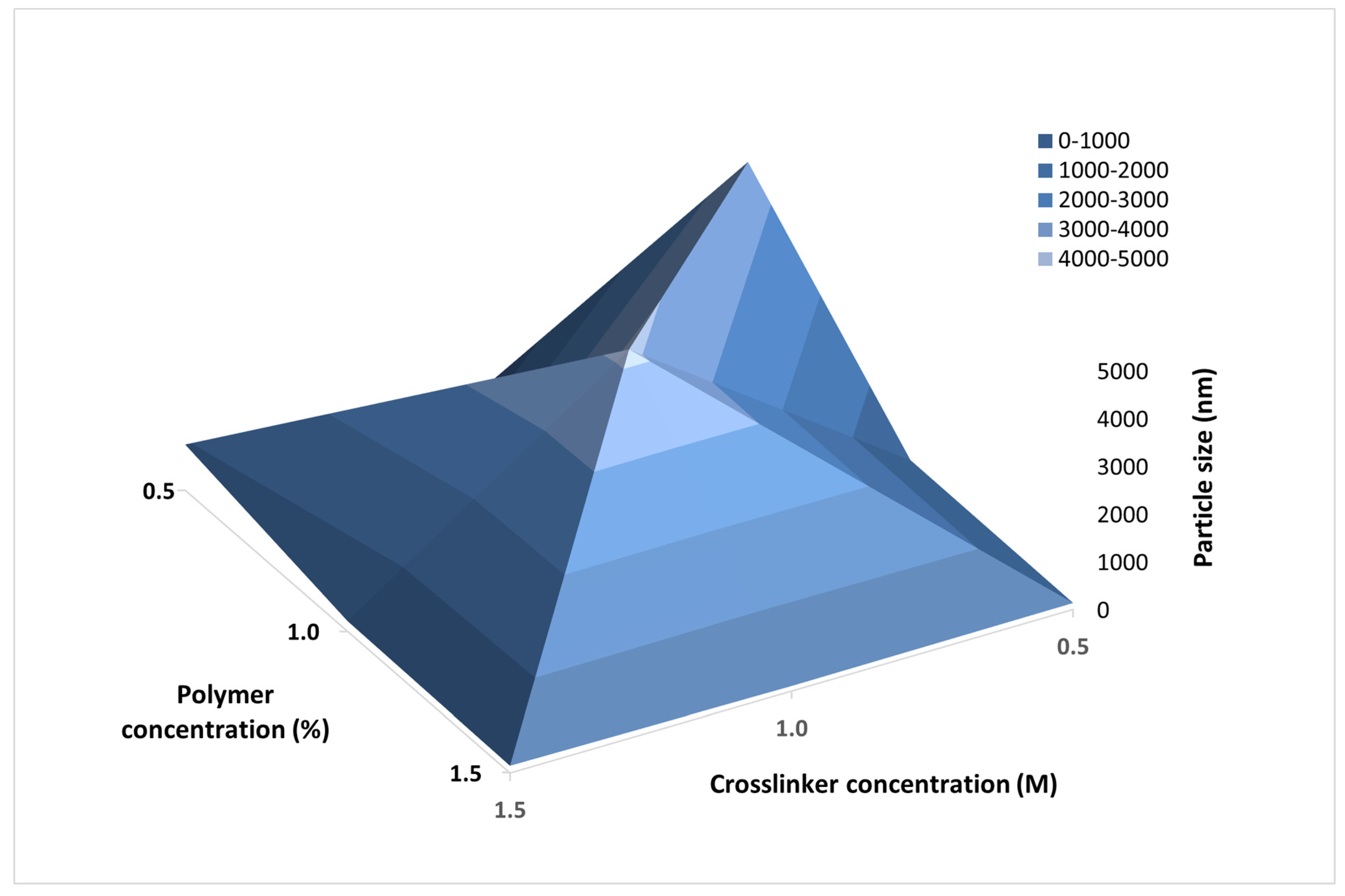


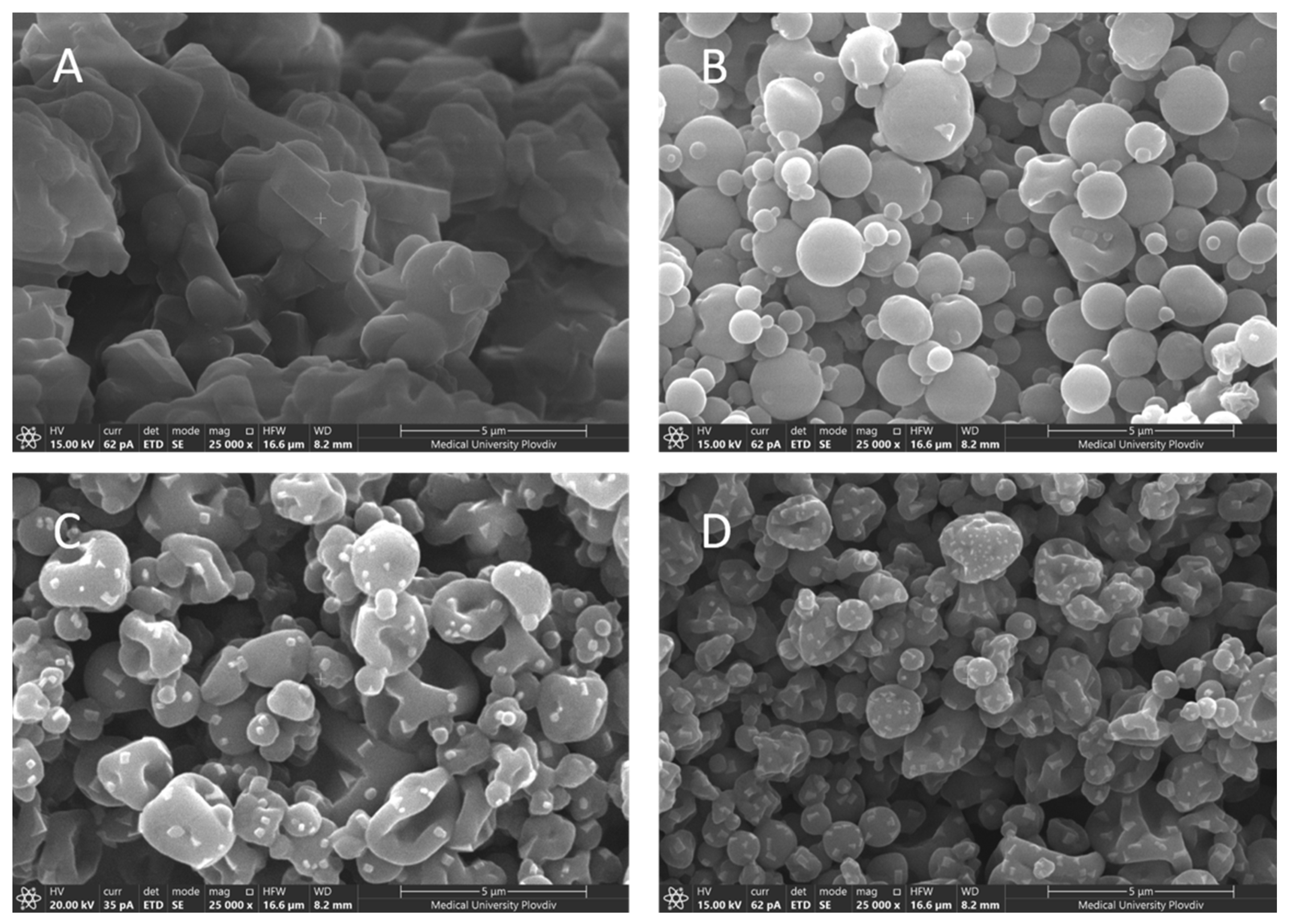
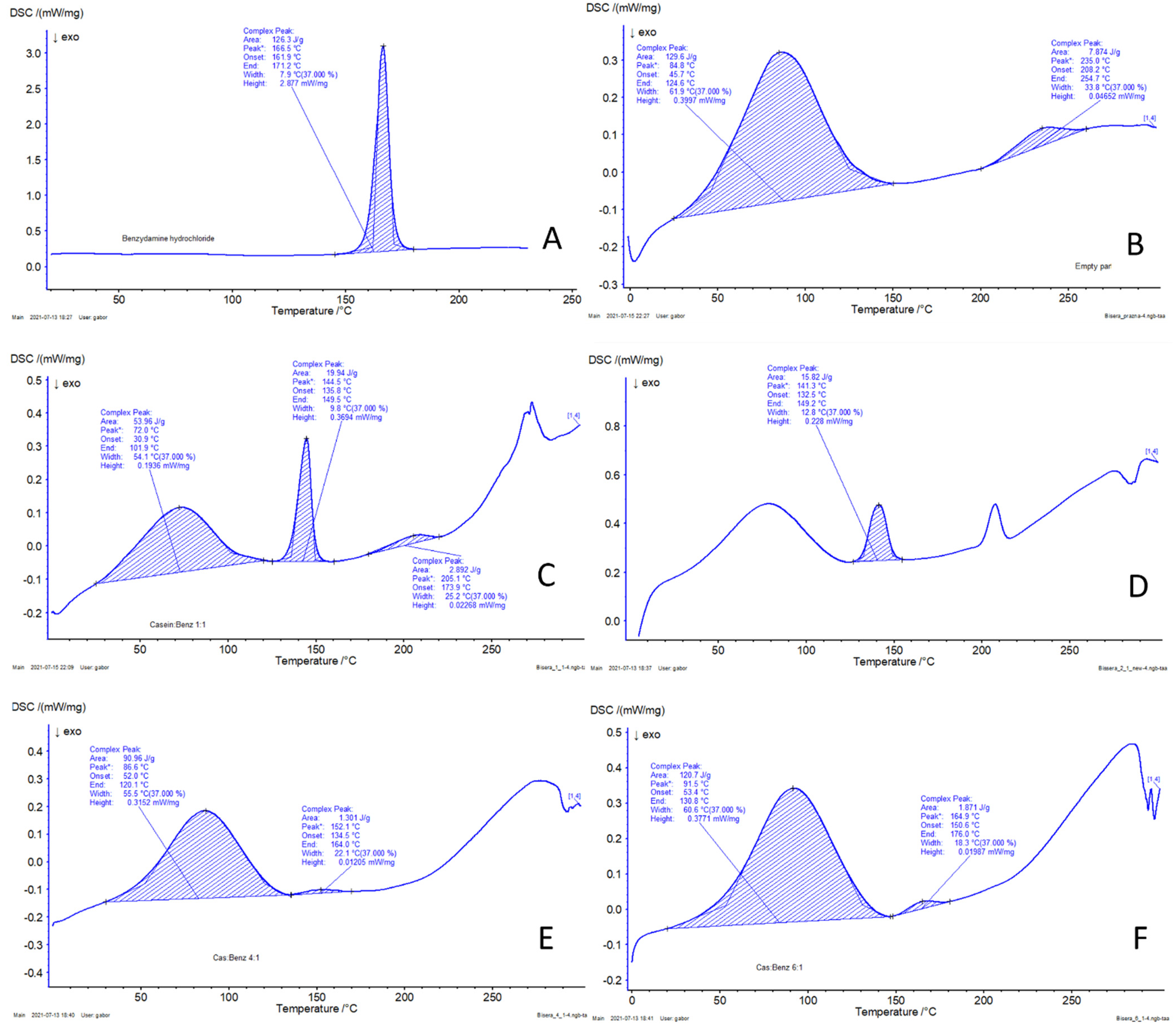
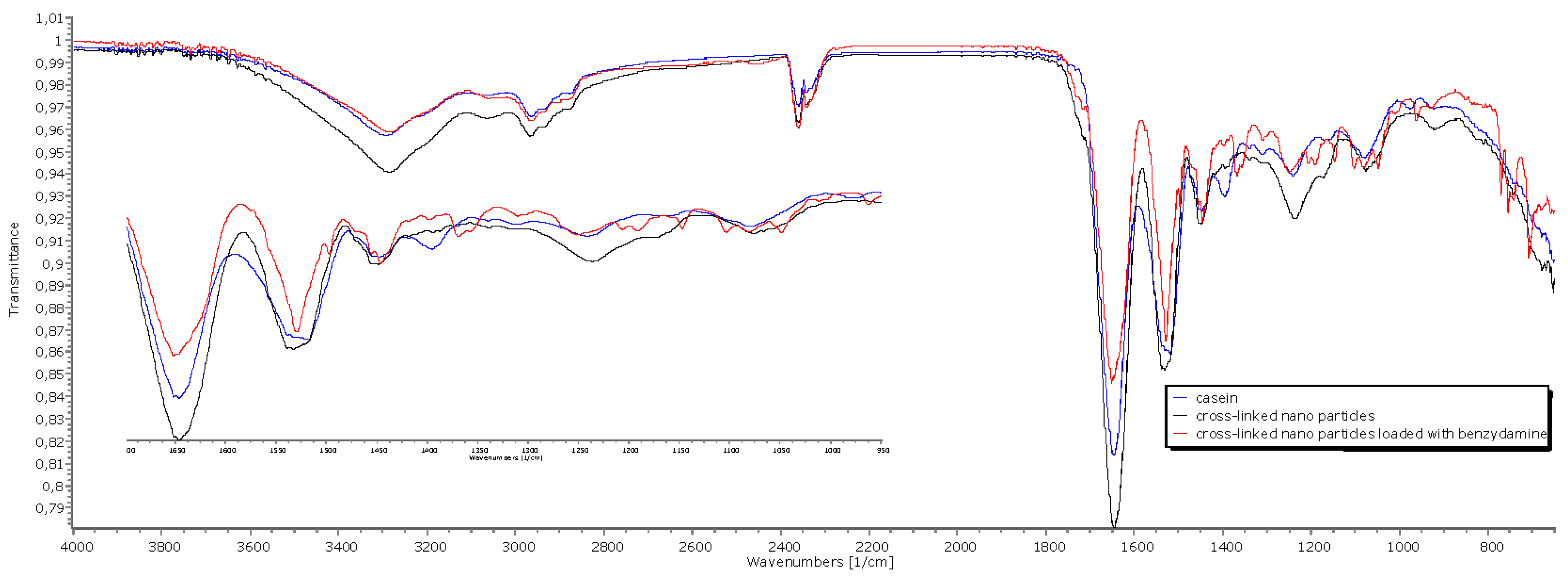
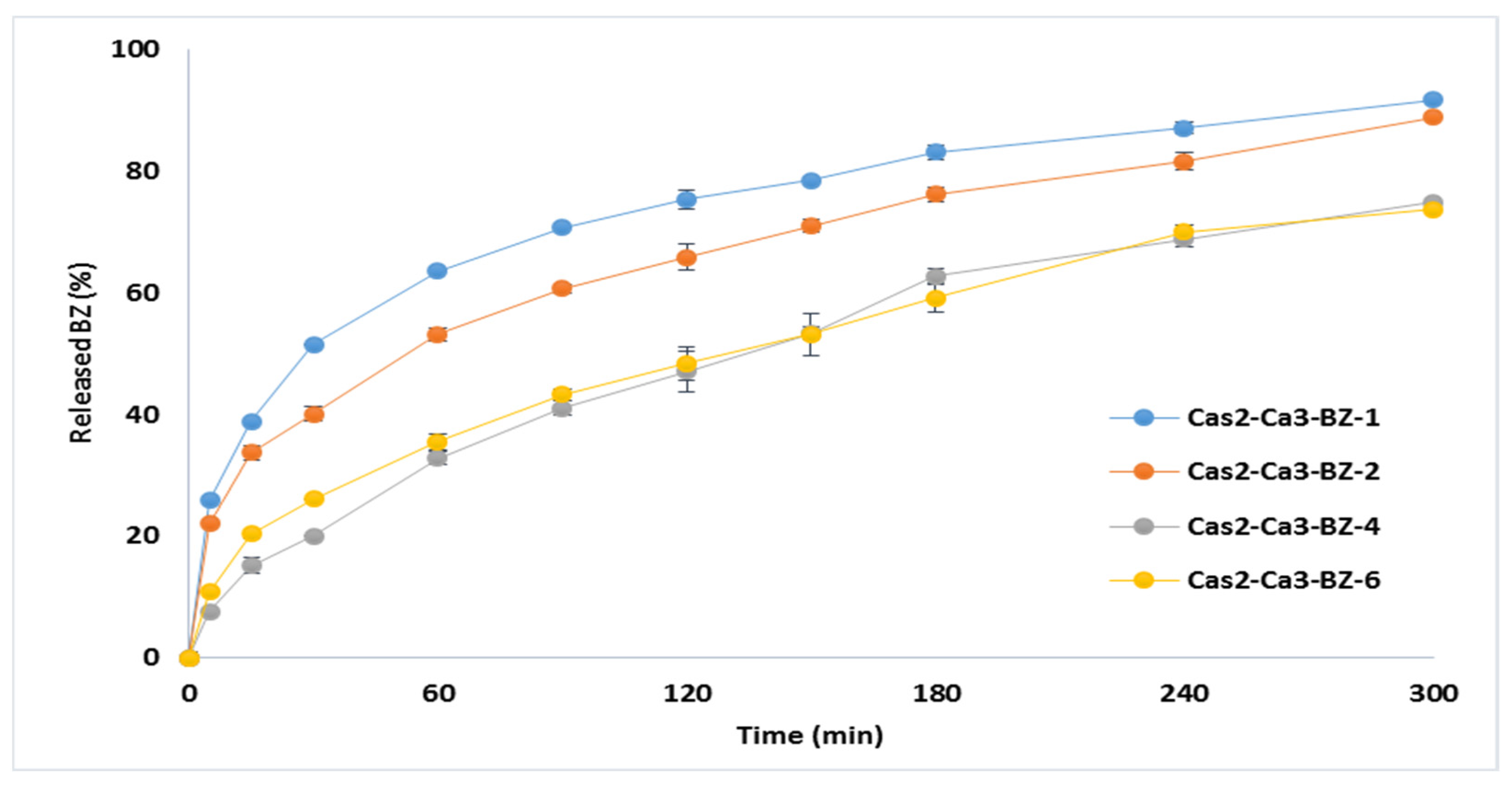
| Sample Code | Variables | Dv10 ± SD (nm) | Dv50 ± SD (nm) | Dv90 ± SD (nm) | PDI | ζ ± SD (mV) | Yeild ± SD (%) | |
|---|---|---|---|---|---|---|---|---|
| Polymer (%) | Crosslinker (M) | |||||||
| Cas1-Ca1 | 0.5 | 0.5 | 2885.0 ± 5.26 | 3470.0 ± 22.3 | 4020.0 ± 6.6 | 109.20 | −15.4 ± 0.4 | 37.87 ± 9.26 |
| Cas1-Ca2 | 0.5 | 1.0 | 48.5 ± 2.04 | 174.5 ± 4.1 | 256.1 ± 2.7 | 8.44 | −22.5 ± 0.8 | 43.54 ± 2.04 |
| Cas1-Ca3 | 0.5 | 1.5 | 46.1 ± 7.25 | 133.2 ± 1.6 | 2156.0 ± 4.7 | 34.47 | −19.0 ± 0.6 | 50.30 ± 7.25 |
| Cas2-Ca1 | 1.0 | 0.5 | 89.8 ± 2.83 | 138.1 ± 3.5 | 463.2 ± 3.0 | 22.68 | −17.0 ± 0.7 | 49.57 ± 2.83 |
| Cas2-Ca2 | 1.0 | 1.0 | 51.3 ± 4.55 | 4190.0 ± 20.2 | 6050.0 ± 3.2 | 543.90 | −13.3 ± 0.7 | 40.88 ± 4.55 |
| Cas2-Ca3 | 1.0 | 1.5 | 36.5 ± 3.02 | 104.1 ± 8.5 | 191.0 ± 9.0 | 1.21 | −23.6 ± 0.6 | 64.80 ± 3.02 |
| Cas3-Ca1 | 1.5 | 0.5 | 91.8 ± 2.57 | 956.2 ± 14.3 | 5556.0 ± 5.1 | 6.18 | −17.9 ± 0.7 | 51.04 ± 2.57 |
| Cas3-Ca2 | 1.5 | 1.0 | 115.0 ± 4.50 | 212.9 ± 2.9 | 1362.0 ± 7.9 | 8.06 | −15.1 ± 0.5 | 35.04 ± 4.50 |
| Cas3-Ca3 | 1.5 | 1.5 | 90.1 ± 2.69 | 149.2 ± 2.6 | 2944.0 ± 4.0 | 13.21 | −16.3 ± 0.5 | 57.68 ± 2.69 |
| Sample Code | Sodium Caseinate (%) | Benzydamine HCl (mg) | Variables | |
|---|---|---|---|---|
| Polymer: Drug Ratio | ||||
| Cas2-Ca3-BZ-1 | 1.5 | 1.500 | 1 | 1 |
| Cas2-Ca3-BZ-2 | 1.5 | 0.750 | 2 | 1 |
| Cas2-Ca3-BZ-4 | 1.5 | 0.375 | 4 | 1 |
| Cas2-Ca3-BZ-6 | 1.5 | 0.250 | 6 | 1 |
| Sample Code | Particle Size ± SD (nm) | ζ ± SD (mV) | DL ± SD (%) | EE ± SD (%) | Yield ± SD (%) |
|---|---|---|---|---|---|
| Cas2-Ca3-BZ-1 | 994.2 ± 2.21 | 18.11 ± 0.86 | 57.41 ± 0.27 | 34.61 ± 0.23 | 30.42 ± 4.28 |
| Cas2-Ca3-BZ-2 | 243.6 ± 2.47 | 16.33 ± 0.55 | 35.04 ± 034 | 78.82 ± 0.39 | 74.71 ± 5.41 |
| Cas2-Ca3-BZ-4 | 159.8 ± 2.43 | 15.24 ± 0.58 | 26.21 ± 0.22 | 76.23 ± 0.28 | 68.76 ± 5.01 |
| Cas2-Ca3-BZ-6 | 1359 ± 1.73 | 14.23 ± 0.66 | 16.02 ± 0.31 | 77.44 ± 0.57 | 58.23 ± 5.08 |
Publisher’s Note: MDPI stays neutral with regard to jurisdictional claims in published maps and institutional affiliations. |
© 2021 by the authors. Licensee MDPI, Basel, Switzerland. This article is an open access article distributed under the terms and conditions of the Creative Commons Attribution (CC BY) license (https://creativecommons.org/licenses/by/4.0/).
Share and Cite
Zahariev, N.; Marudova, M.; Milenkova, S.; Uzunova, Y.; Pilicheva, B. Casein Micelles as Nanocarriers for Benzydamine Delivery. Polymers 2021, 13, 4357. https://doi.org/10.3390/polym13244357
Zahariev N, Marudova M, Milenkova S, Uzunova Y, Pilicheva B. Casein Micelles as Nanocarriers for Benzydamine Delivery. Polymers. 2021; 13(24):4357. https://doi.org/10.3390/polym13244357
Chicago/Turabian StyleZahariev, Nikolay, Maria Marudova, Sophia Milenkova, Yordanka Uzunova, and Bissera Pilicheva. 2021. "Casein Micelles as Nanocarriers for Benzydamine Delivery" Polymers 13, no. 24: 4357. https://doi.org/10.3390/polym13244357
APA StyleZahariev, N., Marudova, M., Milenkova, S., Uzunova, Y., & Pilicheva, B. (2021). Casein Micelles as Nanocarriers for Benzydamine Delivery. Polymers, 13(24), 4357. https://doi.org/10.3390/polym13244357










